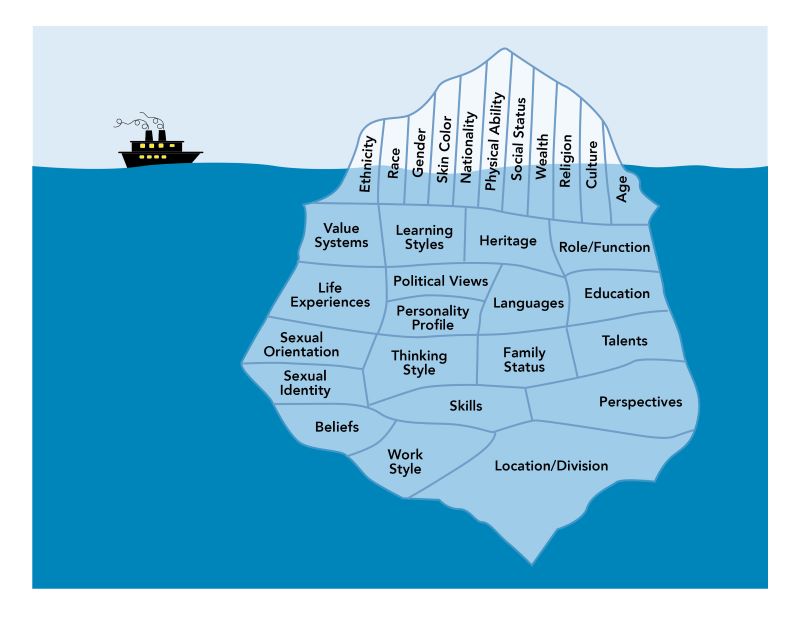Culture
What is it?
When working with children and families, you will routinely encounter people who have identities, values, beliefs, and lifestyles that differ from your own. It is not only crucial that you recognize these differences but that you also strive to value and appreciate these differences. Whenever possible, empower the children and families you serve as leaders to help incorporate cultural elements as strengths in services.
When we say culture, what do we mean? A person’s culture is often attributed to “diversity” — race and ethnicity, age, gender and sex, sexual orientation, and disability status — or it can be connected to other parts of our identity, such as our religion or faith, political views, rural vs. urban environment, family values, or our socio-economic status. Each of these is equally important, and we must continue to keep an open mind to the broad meaning of culture to see our clients as a whole. This broad-based view of culture can also help us expand our experiences with people different from ourselves to reduce stereotypes based on cultural groups.

Why does it matter?
No one works within a vacuum with people who look, think, believe, and behave exactly like themselves. Even within a family in Montana, you can find cultural diversity and richness. As we strive to provide high-quality services to improve services for children and families, it's essential to create systems that value difference. Historically and still in society, many businesses practice, government institutions such as schools, and systems such as health care and the justice system have embodied unjust and discriminatory practices.
One glaring example of this is among the Native American population. Native Americans have experienced mistreatment in a variety of ways — being forced from their ancestral homelands, forbidden from practicing their religion, taken from their families and placed in boarding schools, forced to adapt to white beauty standards (i.e., cutting of hair), and denied rights such as land ownership and voting rights. Native Americans also have persistent negative stereotypes in today's society, such as the firewater myth — in which indigenous people are more susceptible to alcoholism. As a group, Native Americans are also overrepresented in Montana's missing person registration, foster care system, and juvenile and adult justice systems.
Many rural Montana's also experience a lack of easy access to quality health care, education, and grocery stores creating food deserts due to their remoteness. It would help if you continued to work with clients to expand your definition of culture beyond only race and ethnicity because we need to acknowledge and appreciate the unique differences between all humans.
Practice strategies that work
1. Invest in yourself
Identify and examine your own culture. To start, reflect on the following:
- What parts of your identity do you openly and proudly share?
- What aspects of your identity do you keep more guarded?
- What stereotypes and misinformation exist about people in various cultural groups?
- What have you internalized about the value of different parts of culture? Positive messages? Negative stereotypes?
- How can you leverage similarities with clients to build rapport?
- What barriers might exist because of your differences?
2. Start the conversation
Consider growth opportunities in the workplace by completing a self-assessment on working with diverse populations. Once you have your results, consider sharing them with your supervisor and finding ongoing professional development opportunities and coaching opportunities.
3. Build Trust
Draw on the client's culture to shape services. To do this, you will need to authentically work with families and local communities to understand the strengths of their culture. A fundamental way to accomplish this is by allowing children and families a leadership role in creating all service plans, determining service delivery methods, and using culturally relevant interventions
4. Action
As you continue to work with team members and your supervisor, find spaces to think through your agency's power dynamics and imbalances. Employ solution-focused methods to use internal resources and partners to address and create more equitable systems.
Examples could include: conducting an evaluation of client satisfaction regarding their experiences in your office and with staff, developing a client advisory board to provide feedback, drafting new policies to address bias and barriers to services, or advocating for policy changes with clients within the organization or larger systems.
Additional Resources
National Child Welfare Workforce Institute This list of resources supports child welfare staff and leaders as they confront implicit bias, implement system changes and work to achieve racial equity within their organizations and across systems.
Casey Family Programs Helps professionals and families understand the unique needs of urban, suburban, and rural child welfare practitioners in best-supporting children and families.
Moving Toward Cultural Competence An overview of critical attitudes and approaches for working towards cultural competency with questions and opportunities for growth
Tribal Sovereignty and Child Welfare Practice tips for social workers to understand government to government relations in ICWA cases
What is cultural competence, and why is it important?
Find these books at your local library.
Far From the Tree by Andrew Solomon
Crip Camp The experiences of one group of disabled young people and their journey to activism and adulthood. It also allows all to delve into the rich and complicated history of disability activism, culture, and history.
The full feature of Crip Camp is available on Netflix and YouTube.
Love, no matter what What is it like to raise a child who's different from you in some fundamental way (like a prodigy, or a differently abled kid, or a criminal)? In this quietly moving talk, writer Andrew Solomon shares what he learned from talking to dozens of parents -- asking them: What's the line between unconditional love and unconditional.
Adoptive Couple v. Baby Girl This is the story of a three-year-old girl and the highest court in the land. The Supreme Court case Adoptive Couple v. Baby Girl is a legal battle that has entangled a biological father, a heartbroken couple, and the tragic history of Native American children taken from their families.
10 Podcasts That Inspire Cultural Awareness
People are Culture Interview series celebrates unique differences and shared human conditions and presents stories of how culture is created, preserved, and shared.
Engaging Indigenous Families and Communities Insights for caseworkers and agencies working with indigenous communities to help support children and families.
Project Implicit A training designed to educate individuals about their own conscious or subconscious bias.
Empower Montana Creating a more just and inclusive society by developing youth and adult leaders who work to end mistreatment, correct systemic inequalities, and strengthen communities across Montana.
Rural Institute for Inclusive Communities Promoting equal opportunity for people with disabilities through education, research and direct service.
